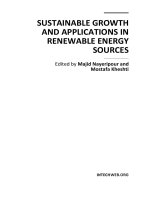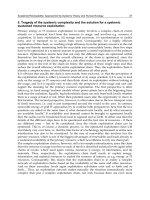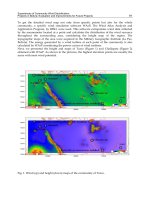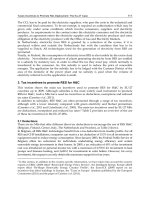Acoustic sensing roles and applications in monitoring avian biodiversity
Bạn đang xem bản rút gọn của tài liệu. Xem và tải ngay bản đầy đủ của tài liệu tại đây (4.63 MB, 200 trang )
ACOUSTIC SENSING: ROLES AND
APPLICATIONS IN MONITORING AVIAN
BIODIVERSITY.
Jason Wimmer
BComp (Monash University)
GCSc (University of Queensland)
A thesis by publication submitted in fulfilment of the requirements for the degree of
Doctor of Philosophy
June 2015
§
Principal Supervisor: Prof Paul Roe
Associate Supervisor: Dr Ian Williamson
Science and Engineering Faculty
Electrical Engineering, Computer Science
Queensland University of Technology
Brisbane, Queensland, Australia
Keywords
Acoustic Sensing, Avian Survey Techniques, Biodiversity Monitoring, Sampling
ii
Acoustic sensing: roles and applications in monitoring Avian biodiversity.
Abstract
Biodiversity monitoring at large spatial and temporal scales is becoming
increasingly important as the effects of climate change and habitat loss threaten the
natural environment. Environmental sensors such as acoustic sensors are becoming
important for achieving this; they can remain deployed, passively collecting data over
large areas for long periods of time, and they can detect species such as birds and frogs,
which can be good indicators of overall environmental condition. However, acoustic
sensors can generate large volumes of data which must be analysed to identify
vocalisations of individual species. In addition acoustic sensor data can be complex
and difficult to analyse. Many bird species exhibit considerable regional variation, and
environmental noise such as rain and wind can make species identification difficult.
This thesis investigates some of the major challenges and opportunities
presented by acoustic sensing for biodiversity monitoring. Tools for manually
analysing large volumes of data are presented, along with the results of a detailed
analysis of a typical acoustic sensor survey. A comparison of traditional survey
methods and acoustic sensor surveys is presented, along with approaches for reducing
manual analysis effort through the use of sampling techniques.
In the absence of automated analysis tools for a large number of species, acoustic
sensor data must be analysed by experienced bird surveyors. This thesis presents a
system for managing the manual analysis of large volumes of acoustic sensor data. The
system generates spectrograms, plays audio and allows users to annotate spectrograms
to identify individual species. The system was used to manually analyse acoustic
sensor data, the results of which, form the basis of the research presented in this thesis.
Acoustic sensing: roles and applications in monitoring Avian biodiversity.
iii
Acoustic sensor data can provide unique insights into species behaviour which
go beyond typical species richness or abundance estimates obtained from traditional
surveys. A major component of this research was the analysis of five days of
continuous acoustic sensor recordings from four sites. Calls were analysed by
experienced bird surveyors and each species identified in each one minute segment
annotated. In total, 28,800 one minute segments were analysed, 63,089 calls annotated
and 96 bird species identified. From this data, detailed call frequency, diurnal
variation, species accumulation, periods of high and low activity and the effects of
weather on detectability were investigated. Additionally, a high resolution, fully
annotated acoustic data set was created, which allowed for comparisons with
traditional survey methods and testing of sampling methods to reduce manual analysis
effort. To our knowledge this is the most comprehensively analysed acoustic data set
of its kind, which will be of ongoing use for future research, including development
and testing of automated species recognition tools.
Users of acoustic sensor technology require an objective assessment of the
capabilities of acoustic sensors compared to traditional survey methods. Previous
comparisons of traditional and acoustic sensor surveys have produced conflicting
results. In this thesis, the results of detailed comparisons between traditional bird
surveys and the manually analysed acoustic sensor data are presented. Acoustic sensor
surveys consistently detected a higher number of species than traditional surveys,
although the cost of analysis also increased significantly.
Analysis of acoustic sensor data is time consuming and costly. Automated
analysis tools which can reliably detect a large number of bird species are yet to be
developed. In the interim, users of acoustic sensor data technology require a means to
efficiently manually analyse acoustic data. The final section of this thesis examined
iv
Acoustic sensing: roles and applications in monitoring Avian biodiversity.
the use of sampling methods to reduce the cost of analysing large volumes of acoustic
sensor data, while retaining high levels of species detection accuracy.
In this thesis, I present a series of original research publications which, when
combined, make a significant and original contribution to our understanding of the
appropriate application of acoustic sensing technology for large-scale biodiversity
monitoring. This includes the demonstration of a system to manage and process large
volumes of acoustic sensor data, examples of ecological insights which can be
obtained from analysis of acoustic sensor data, a detailed comparison between acoustic
sensor surveys and traditional surveys, and sampling strategies for analysing large
volumes of data manually.
Acoustic sensing: roles and applications in monitoring Avian biodiversity.
v
Table of Contents
Keywords ................................................................................................................................................ii
Abstract ................................................................................................................................................. iii
Table of Contents ................................................................................................................................... vi
List of Figures ........................................................................................................................................ ix
List of Tables ......................................................................................................................................... xi
List of Publications and Manuscripts ....................................................................................................xii
Statement of Original Authorship ....................................................................................................... xiii
Acknowledgments ................................................................................................................................ xiv
CHAPTER 1: INTRODUCTION ....................................................................................................... 1
1.1
Significance and Contribution ..................................................................................................... 3
1.2
Account of Research Progress Linking the Research Papers ....................................................... 5
CHAPTER 2: LITERATURE REVIEW ........................................................................................... 9
2.1
Background .................................................................................................................................. 9
2.2
Monitoring Biodiversity ............................................................................................................ 11
2.3
Animal Communication and Sound ........................................................................................... 12
2.3.1 Why do animals communicate? ...................................................................................... 12
2.3.2 When do Animals Communicate? .................................................................................. 13
2.4
Traditional Field Survey Methods ............................................................................................. 14
2.4.1 Survey Types .................................................................................................................. 15
2.4.2 Sampling ......................................................................................................................... 17
2.5
Sensors ....................................................................................................................................... 18
2.5.1 Sensor Technology ......................................................................................................... 18
2.5.2 Cameras .......................................................................................................................... 19
2.5.3 Environmental Sensors ................................................................................................... 20
2.5.4 Acoustic Sensors ............................................................................................................ 20
2.6
Applications for Acoustic Sensing in Biodiversity Monitoring ................................................. 23
2.6.1 Localisation .................................................................................................................... 23
2.6.2 Species Abundance ......................................................................................................... 23
2.6.3 Species Richness and Single Species Behavioural Studies ............................................ 24
2.6.4 Acoustic Sensors vs Traditional Survey Methods .......................................................... 25
2.7
Sensor Data Analysis ................................................................................................................. 27
2.7.1 Manual Analysis ............................................................................................................. 27
2.7.2 Automated Analysis ....................................................................................................... 28
2.7.3 Participatory Analysis/Citizen Science ........................................................................... 31
2.8
Summary and Implications ........................................................................................................ 32
CHAPTER 3: ANALYSING ENVIRONMENTAL ACOUSTIC DATA THROUGH
COLLABORATION AND AUTOMATION .................................................................................... 34
3.1
Statement of Contribution of Co-Authors .................................................................................. 35
3.2
Abstract ...................................................................................................................................... 36
3.3
Introduction................................................................................................................................ 37
3.4
Online Environmental Workbench ............................................................................................ 39
3.4.1 Acoustic Data Upload and Storage ................................................................................. 39
3.4.2 Acoustic Data Organisation and Structure...................................................................... 40
vi
Acoustic sensing: roles and applications in monitoring Avian biodiversity.
3.4.3 Recording Playback and Visualisation ........................................................................... 42
3.4.4 Recording Analysis and Annotation ............................................................................... 43
3.4.5 Discussion and Review Facility ...................................................................................... 44
3.5
Online Analysis Techniques ...................................................................................................... 46
3.5.1 Manual Analysis ............................................................................................................. 47
3.5.2 Automated Call Recognition .......................................................................................... 49
3.5.3 Human-in-the-Loop Analysis ......................................................................................... 55
3.6
System Implementation ............................................................................................................. 58
3.7
Related Systems ......................................................................................................................... 60
3.8
Discussion and Future Work ...................................................................................................... 62
3.9
Acknowledgments...................................................................................................................... 65
CHAPTER 4: ASSESSING BIRD BIODIVERSITY WITH ACOUSTIC SENSORS –
INSIGHTS FROM AVIAN SURVEYS IN SOUTH-EAST QUEENSLAND. ............................... 67
4.1
Statement of Contribution of Co-Authors .................................................................................. 68
4.2
Abstract ...................................................................................................................................... 69
4.3
Introduction ................................................................................................................................ 71
4.4
Methods ..................................................................................................................................... 73
4.4.1 Site Description .............................................................................................................. 73
4.4.2 Acoustic Sensors............................................................................................................. 74
4.4.3 Acoustic Sensor Data Analysis ....................................................................................... 75
4.4.4 Meteorological Data ....................................................................................................... 76
4.4.5 Statistical Analysis.......................................................................................................... 76
4.5
Results ........................................................................................................................................ 77
4.5.1 Richness and Similarity .................................................................................................. 77
4.5.2 Call Frequency ................................................................................................................ 79
4.5.3 Variation In Calling ........................................................................................................ 81
4.6
Discussion .................................................................................................................................. 85
Acknowledgements ............................................................................................................................... 88
CHAPTER 5: DO THE EYES HAVE IT? – A COMPARISON OF TRADITIONAL BIRD
SURVEYS AND ACOUSTIC SENSOR SURVEYS. ....................................................................... 89
5.1
Statement of Contribution of Co-Authors .................................................................................. 90
5.2
Abstract ...................................................................................................................................... 91
5.3
Introduction ................................................................................................................................ 93
5.4
Methods ..................................................................................................................................... 96
5.4.1 Sites 96
5.4.2 Traditional Bird Surveys ................................................................................................. 97
5.4.3 Acoustic Sensors............................................................................................................. 97
5.4.4 Acoustic Data Analysis................................................................................................... 98
5.4.5 Comparisons ................................................................................................................... 98
5.5
Results ...................................................................................................................................... 100
5.5.1 Survey Period Comparison ........................................................................................... 100
5.5.2 Differences in Species Composition ............................................................................. 103
5.5.3 Effect of Observers on Calling Behaviour .................................................................... 105
5.5.4 Cost Comparison .......................................................................................................... 106
5.6
Discussion ................................................................................................................................ 108
Acknowledgements ............................................................................................................................. 112
CHAPTER 6: SAMPLING ENVIRONMENTAL ACOUSTIC RECORDINGS TO
DETERMINE SPECIES RICHNESS. ............................................................................................ 114
Acoustic sensing: roles and applications in monitoring Avian biodiversity.
vii
6.1
Statement of Contribution of Co-Authors ................................................................................ 115
6.2
Abstract .................................................................................................................................... 116
6.3
Introduction.............................................................................................................................. 117
6.4
Materials and Methods............................................................................................................. 120
6.4.1 Study site ...................................................................................................................... 120
6.4.2 Acoustic Sensors .......................................................................................................... 121
6.4.3 Acoustic Sensor Data Analysis ..................................................................................... 122
6.4.4 Sampling Methods ........................................................................................................ 123
6.4.5 Traditional Area Search Surveys .................................................................................. 125
6.4.6 Statistical Analysis ....................................................................................................... 125
6.5
Results ..................................................................................................................................... 126
6.5.1 Survey Results .............................................................................................................. 126
6.5.2 Acoustic Data Sampling Results .................................................................................. 129
6.6
Discussion ................................................................................................................................ 135
6.7
Acknowledgements .................................................................................................................. 137
CHAPTER 7: CONCLUSIONS ...................................................................................................... 140
7.1
Summary and Contributions .................................................................................................... 140
BIBLIOGRAPHY ............................................................................................................................. 148
APPENDICES ................................................................................................................................... 169
Appendix A: List of Sensor Survey Species Detected ............................................................. 169
Appendix B: List of Traditional Survey Species Detected ...................................................... 173
Appendix C: Copies of Published Manuscripts ....................................................................... 175
viii
Acoustic sensing: roles and applications in monitoring Avian biodiversity.
List of Figures
Figure 1. Workbench data organisation and structure. .......................................................................... 41
Figure 2. Workbench playback tool with annotated species vocalisations. ........................................... 43
Figure 3. Semi-automated analysis (human-in-the-loop) ...................................................................... 57
Figure 4. System Architecture ............................................................................................................... 58
Figure 5. Samford Ecological Research Facility (SERF) with survey site postions marked with
black squares and weather station position marked with a blue diamond. ........................... 74
Figure 6. Spectrogram with annotated Bush Stone Curlew (Burhinus grallarius) call
( ........................................................................................ 75
Figure 7. Mean and total number of bird species detected daily (± 95% CI) at each site. .................... 77
Figure 8. Species accumulation curves and Chao2 estimate of species richness for all sites
across five days. ................................................................................................................... 78
Figure 9. Call frequency distribution for all species over the survey period. ........................................ 80
Figure 10. Call frequency distribution for species with less than 550 calls detected over the
survey period. ....................................................................................................................... 81
Figure 11. Mean species detected per minute across four sites and five days. ...................................... 83
Figure 12. Mean bird species detected per hour (± 95% CI) across four sites and five days. ............... 83
Figure 13. Mean species detected per day (sites as replicates) .............................................................. 84
Figure 14. Average wind speed for each day over the 5 day survey period. ......................................... 84
Figure 15. The relationship between numbers of species detected and average wind speed per
hour, for three different periods of the day (7-9am; 9am-2pm; and 2-7pm). ....................... 85
Figure 16. Samford Ecological Research Facility with survey sites indicated as black squares. .......... 97
Figure 17. Number of unique species detected per site over five days by traditional surveys,
sensor surveys corresponding to traditional survey times, and full sensor surveys. ........... 100
Figure 18. Species accumulation curves for Sensor and Traditional surveys (for corresponding
20 minute dawn, noon and dusk survey periods). Points are total number of species
detected across all sites. ..................................................................................................... 101
Figure 19 Mean number of species detected from sensor and traditional surveys for
corresponding 20 minute dawn, noon and dusk survey periods (± 95% CI). ..................... 102
Figure 20. Mean number of species detected daily (aggregated from dawn, noon and dusk
survey periods) for traditional and sensor surveys (± SEM). ............................................. 103
Figure 21. Mean number of minutes (and standard error) taken to manually analysis one minute
of acoustic sensor data at different times of the day. Values for Dawn, Noon and
Dusk Survey periods were calculated using one minute segments corresponding to
the 20 minute traditional surveys. ...................................................................................... 107
Figure 22. Samford Ecological Research Facility (SERF) with survey site positions. ....................... 121
Figure 23. Total number of unique bird species detected and Chao2 species richness estimates
for full acoustic sensor data analysis and traditional survey, for each site over the
five-day survey period. ....................................................................................................... 127
Figure 24. Mean number of bird species detected daily from full acoustic sensor data analysis
and traditional survey for each site over the five-day survey period (± 95% CI). .............. 128
Figure 25. Mean number of species detected per hour from full analysis of acoustic sensor data
across all sites (± 95% CI). ................................................................................................. 128
Acoustic sensing: roles and applications in monitoring Avian biodiversity.
ix
Figure 26. Mean percentage of total species detected for each sampling method for the
associated number of minutes sampled (Data combined over sites). ................................. 131
Figure 27. Mean percentage of total species detected by each sampling method for the
associated number of minutes sampled. Error bars for each group of samples have
been offset for clarity. ........................................................................................................ 134
x
Acoustic sensing: roles and applications in monitoring Avian biodiversity.
List of Tables
Table 1. Recogniser results from experiments using four automated recognition techniques. ............. 53
Table 2. The maximum number and percentage of species detected [square brakets] for each
sampling method from full manual analysis of sensor data, along with the minimum
number of samples required to detect the maximum number of species (greedy
algorithm). Results are presented for each site, and the mean of all sites. ......................... 130
Table 3. Tukey post hoc test results for traditional survey against each sensor survey sampling
method, and sampling effort up to 300 samples. Results are significant (p < 0.05) for
all sampling methods and sampling effort with the exception of Dusk at 120 samples
and higher. .......................................................................................................................... 134
Acoustic sensing: roles and applications in monitoring Avian biodiversity.
xi
List of Publications and Manuscripts
The following is a list of manuscripts accepted for publication as part of this thesis:
Wimmer, J., Towsey, M., Planitz, B., Williamson, I., Roe, P. (2012). Analysing
environmental acoustic data through collaboration and automation. Future
Generation Computer Systems, 29(2), 560-568.
/>
Wimmer, J., Michael Towsey, Paul Roe, and Ian Williamson. (2013). Sampling
environmental acoustic recordings to determine bird species richness. Ecological
Applications 23(6):1419–1428. />
xii
Acoustic sensing: roles and applications in monitoring Avian biodiversity.
Statement of Original Authorship
The work contained in this thesis has not been previously submitted to meet
requirements for an award at this or any other higher education institution. To the best
of my knowledge and belief, the thesis contains no material previously published or
written by another person except where due reference is made.
QUT Verified Signature
Signature:
Date:
10/6/2015
Acoustic sensing: roles and applications in monitoring Avian biodiversity.
xiii
Acknowledgments
This work would not have been possible without the help, advice and support of
many people. What began as a temporary break from corporate life has become a
journey that has taken me to unexpected places and introduced me to interesting new
people, many of whom have become close friends.
Firstly, thank you to my supervisors Professor Paul Roe and Dr Ian Williamson,
who have been a constant and patient source of advice and guidance. They have
provided the ideal balance of knowledge and experience required for cross-disciplinary
research such as this. Without their support this would not have been possible, and the
rewards from the time spent with both Paul and Ian go far beyond the conferring of a
degree. Ian’s retirement from QUT will be a great loss to both teaching and stand-up
comedy. Fortunately, he will be incapable of completely removing himself from both
pursuits, but hopefully a short break will provide the opportunity to develop and test
new material.
During the course of my research I have been fortunate to meet many talented
and dedicated researchers, who have become friends and colleagues. In particular,
thanks to Dr Bill Ellis and Dr Sean Fitzgibbon from the University of Queensland,
who have provided support, guidance and endless entertainment. Over the course of
this research and numerous field trips to remote islands and locations they have
become good friends and I have been inspired by their dedication and professionalism.
Special thanks also to Dr Michael Towsey. Mike has been a continuous source
of help and advice for not only me, but all research students in the bioacoustics lab
over many years.
xiv
Acoustic sensing: roles and applications in monitoring Avian biodiversity.
Finally, thanks to my wife Sarah and my two beautiful girls Juliette and Chloe.
They are my long-suffering, patient and loving inspiration that make everything I do
worthwhile.
Acoustic sensing: roles and applications in monitoring Avian biodiversity.
xv
Chapter 1: Introduction
The complex and interrelated environmental effects of climate change present
scientists and policy makers with a challenging problem requiring innovative
solutions. With estimates of extinction rates up to 1000 times the natural rate (IUCN
2010), monitoring the effects of climate change on the earth’s biodiversity is becoming
increasingly important.
Monitoring biodiversity allows us to take an inventory of the environment and
to observe changes occurring over time, such as species composition, population size,
range and habitat. Observing and understanding these changes allows us to account for
the value of ecosystem services and to take steps to mitigate the risk of large-scale
species extinctions. To do this however, we require efficient and effective means to
collect and analyse environmental observations at large spatial and temporal scales.
Historically, these observations have been made manually by scientists using
traditional field survey methods. Environmental sensors are being used increasingly to
augment and, in some cases even replace traditional methods.
Environmental sensors which can record detailed observations, consistently and
repeatedly over long periods of time hold great promise for improving our capability
to monitor the environment. These sensors can range from complex satellite-based
systems which scan large geographic areas using multispectral imaging (Brumm
2004), to commodity meteorological sensors that can record basic temperature and
relative humidity (Collins et al. 2006). Rapid advances in information and
communication technology are making more sophisticated sensor devices available
Chapter 1: Introduction
1
more quickly than ever before; however the vast amounts of data we are now able to
collect, need to be analysed and interpreted.
Different sensor devices have different data analysis requirements. Simple data
logging devices such as temperature sensors, record interval data (e.g. 32ºC) which
can be directly understood, and have innate meaning. More complex sensors such as
cameras or acoustic sensors generate data which requires a more sophisticated level of
analysis. These data are rich in information, however also fundamentally opaque and
cannot be interpreted until analyses have been performed to give the data meaning.
Take for example, an acoustic sensor recording of a rainforest habitat; many
different species of birds, frogs or insects could be vocalising simultaneously in the
recording. There may also be the sound of rain or wind, or there may be anthropogenic
noise such as cars or planes. This single recording may contain a significant amount
of information which could help to describe the condition of the rainforest, and the
interpretation of this data may change through time, and in the context of larger spatial
scales. Analysing the recording automatically to extract this information however, is
highly challenging.
Capturing and understanding the scale and complexity of the natural
environment using technology such as video or acoustic sensors, requires sophisticated
analysis capabilities, or alternatively, methods to reduce the complexity or scale.
Automated methods will continue to improve and become more sophisticated, but for
the immediate future, methods which improve the ability of humans to manually
analyse large volumes of sensor data are required. We also need to be able to describe
and understand the limitations of sensor technology to ensure that it is used
appropriately.
2
Chapter 1: Introduction
1.1
SIGNIFICANCE AND CONTRIBUTION
The core theme of this thesis is to critically evaluate the effectiveness of acoustic
sensors as a means for monitoring biodiversity at large spatial and temporal scales.
Acoustic sensors have the potential to play an important role in monitoring
biodiversity. Although only a fraction of the earth’s biodiversity have audible and
consistent vocalisations, many species which do (i.e. birds, frogs and insects) are
considered good surrogates of environmental condition (Slabbekoorn and Peet 2003).
To be used effectively, we must understand the strengths and weaknesses of acoustic
sensors and have the ability to process the large volumes of data associated with
acoustic sensor deployments. The key contributions of this thesis are:
Identifying the role of acoustic sensing in biodiversity monitoring, and
the insights that acoustic sensing can provide over and above traditional
survey methods.
Evaluating the effectiveness of acoustic sensors as a means to monitor
biodiversity, by comparing the results of acoustic sensors data with
traditional field survey methods for bird species.
Developing and testing sampling strategies to allow users of acoustic
sensors to manually analyse sensor data efficiently.
While some research has been conducted comparing acoustic sensing to
traditional field survey (for bird species), the results have been contradictory with
many non-standard comparisons made (Hobson et al. 2002; Hutto and Stutzman 2009;
Rempel et al. 2005). There is therefore, no well-defined, clear guidance on the
effectiveness of acoustic sensors which can facilitate their widespread use as a means
of monitoring biodiversity.
Chapter 1: Introduction
3
To determine the effectiveness of acoustic sensors for monitoring biodiversity,
a rigorous comparison of traditional manual bird surveys and manually analysed
acoustic sensor data has been undertaken as part of this research. This provides clear
and unambiguous guidance on the performance characteristics of acoustic sensors and
makes it possible to quantify the difference in detection rates for traditional and
acoustic sensor methods.
To compliment this, given that automated analysis techniques are not yet capable
of detecting large numbers of species, a range of sampling strategies have been
developed to reduce manual analysis effort. These sampling strategies have been tested
systematically across a large manually analysed acoustic sensor data set, to determine
optimal sampling times and sampling frequencies. This provides consumers of
acoustic sensor data with the capacity to achieve higher rates of species detection than
traditional methods, with effort comparable to traditional methods.
To achieve the goals of this research, a fully manually annotated dataset of five
days replicated at four sites (28,800 one minute segments) of acoustic sensor data, with
detailed species vocalisation data at one minute resolution has been analysed. This
dataset has been the underlying foundation of all comparison work performed during
this research, and will continue to be a valuable source of species vocalisation and
detection data for future research. Work from this thesis has been presented at a
number of national and international conferences and published in high quality, peer
reviewed journals including Future Generation Computer Systems and Ecological
Applications.
4
Chapter 1: Introduction
1.2
ACCOUNT OF RESEARCH PROGRESS LINKING THE RESEARCH
PAPERS
The four research papers presented in this thesis are directly related, and present
the outcomes of this research in a logical and coherent manner. Specifically, they focus
on the use of acoustic sensors for monitoring biodiversity at large spatial and temporal
scales for ecological research. Combined, these papers make a significant and original
contribution to our understanding of the appropriate application of acoustic sensing
technology for large-scale biodiversity monitoring. They address the following key
questions:
Chapter 3: Analysing Environmental Acoustic Data through Collaboration
and Automation. How can we manage, visualise, play, annotate and
summarise acoustic sensor data effectively and efficiently?
Chapter 4: Assessing Bird Biodiversity with Acoustic Sensors – Insights
from Avian Surveys in SE Queensland. What ecological insights, beyond
estimates of species richness, can be derived from acoustic sensor surveys?
Chapter 5: Do the eyes have it? – A comparison of traditional bird surveys
and acoustic sensor surveys. How effective are acoustic sensor surveys (in
terms of species detected and cost) compared to traditional biodiversity
surveys?
Chapter 6: Sampling environmental acoustic recordings to determine
species richness. Can sampling approaches be applied to acoustic sensor
data to reduce the amount of manual analysis required to produce high
estimates of species richness?
Chapter 3 outlines a unique online acoustic data analysis workbench for
identifying and annotating species vocalisations. The workbench provides tools to
Chapter 1: Introduction
5
manage acoustic data, play audio, visualise spectrograms and annotate vocalisations.
In addition, a number of semi-automated tools have been developed, which can assist
in the correct identification of species. These include species call libraries (with
prototypical spectrograms and audio of each species) and species specific automated
recognisers. This workbench was central to the analysis of sensor data for this research.
This chapter was accepted as an original research paper for publication in the Future
Generation Computing Systems Journal in 2013 (Wimmer, Towsey, Planitz, et al.
2013).
Chapter 4 presents the results of full manual analysis of acoustic sensor data
from four survey sites over a five day period, and demonstrates the insights that can
be obtained from comprehensive analysis of acoustic sensor data. These insights
include bird species richness, calling frequency, nocturnal and diurnal variations in
calling and the effects of weather on calling behaviour and detectability. This chapter
was submitted as an original research paper to Austral Ecology in 2013.
Having quantified the results of manually analysed acoustic sensor data in
Chapter 4, Chapter 5 compares the results of manual analysis with traditional surveys.
This chapter discusses the relative strengths and weaknesses of each method, in terms
of both numbers of species detected overall and species detected solely by either
method. It also demonstrates that while comprehensive manual analysis of acoustic
data can yield valuable insights, the overall cost renders large scale manual analysis
prohibitive. This chapter was submitted as an original research paper to the Journal of
Field Ornithology in 2014. Demonstrating that manual sensor data analysis can detect
a greater number of species than traditional survey provides the rationale for
examining methods to reduce manual analysis effort (and therefore cost) in Chapter 6.
6
Chapter 1: Introduction
Chapter 6 presents an alternative to full manual data analysis which can reduce
the analysis effort while maintaining high levels of species detectability. This includes
sampling approaches ranging from random to biologically informed and systematic
methods. This chapter was accepted as an original research paper for publication in
Ecological Applications (Wimmer, Towsey, Roe, et al. 2013)
Chapter 7 concludes and summarises the research, highlighting areas of potential
further work.
Chapter 1: Introduction
7
Chapter 2: Literature Review
2.1
BACKGROUND
Understanding and identifying anthropogenic effects on the environment is
becoming increasingly important as the world recognises the impact of global climate
change and loss of biological diversity. This impact, whether due to overutilisation of
natural resources, agriculture, urbanisation, pollution or any number of other factors,
is rapidly leading to habitat loss, and the resultant loss of species. It is in this context
that it is critical to improve our capability to rapidly and accurately collect and analyse
data to assess the ecological condition of a system at a given point in time.
Traditionally, ecologists have conducted field surveys to detect the presence or
absence of particular species, or describe the biodiversity of a surveyed site. The data
gathered provides valuable insights into the complex relationships between organisms
and the environment and the effects of habitat degradation; however these surveys
require trained ecologists to be present in the field gathering data and making
observations. This work can be time consuming, expensive and limited in terms of
scale. Achieving consistent observations across large temporal and spatial scales
requires significant effort and resources. Often, because of cost constraints, these
resources are not available which can limit the scope or applicability of field work.
This comes at a time when climate change is threatening many species and mitigation
strategies to prevent their loss require detailed species survey and population
distribution data.
Acoustic sensors have been used by ecologists and marine biologists to monitor
biodiversity for some time. Acoustic energy is a unique and potentially valuable tool
for assisting ecologists to perform fauna surveys. Sound can transmit large amounts of
Chapter 2: Literature Review
9









